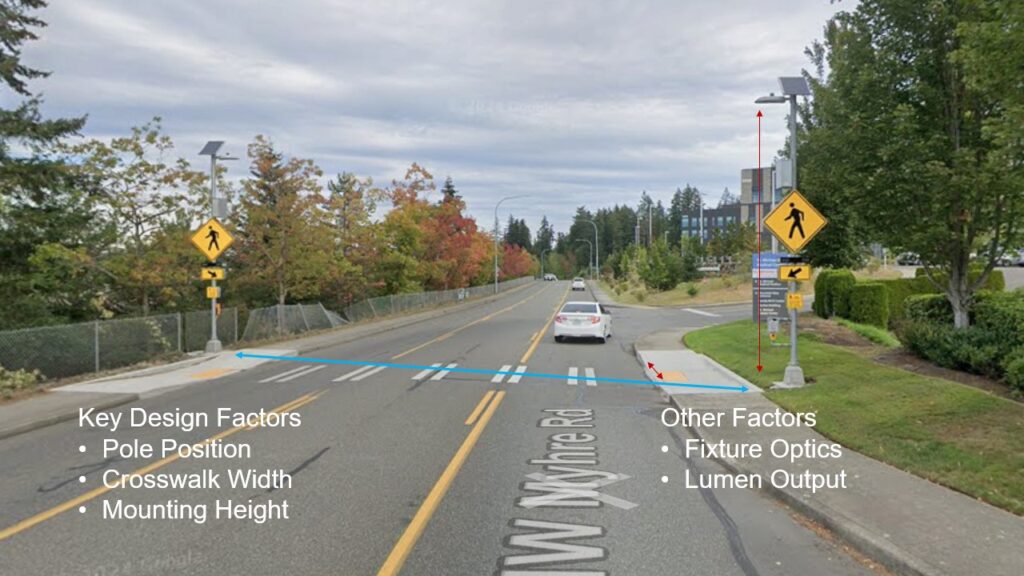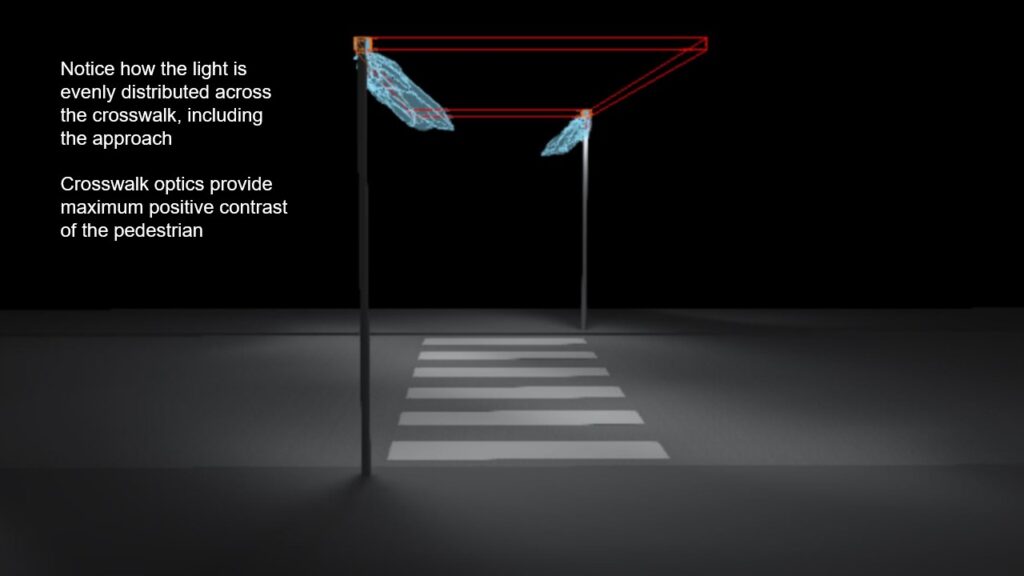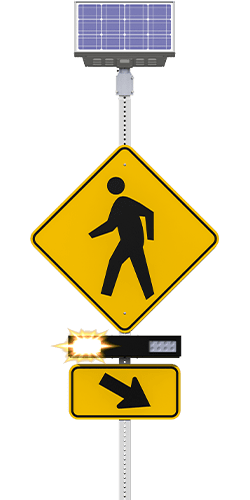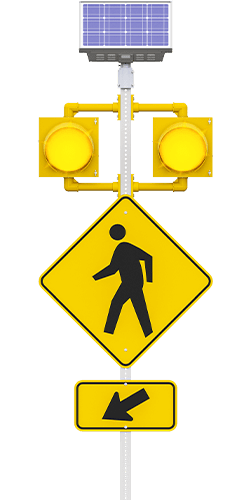MX SeriesTM
Crosswalk Lighting for RRFBs
Increase pedestrian visibility at mid-block crossings with a directional, compliant, and efficient LED crosswalk light.

The number of pedestrian fatalities in North America has risen sharply in the past few years. According to the Governors Highway Safety Association (GHSA), 6,590 pedestrians in the United States were killed in traffic incidents in 2019, the highest number in more than 30 years.
Though there are many reasons for crashes involving pedestrians (cellphones, alcohol, excessive speed), numerous studies have found that inadequate lighting at or near crosswalks presents a heightened risk to pedestrians crossing the road. The nighttime fatal crash rate on unlit roads is almost twice as high as in well-lit areas, with nighttime crashes accounting for more than 90% of the total increase in pedestrian deaths in the past decade.
Crosswalks + connectivity:
R920-MX RRFBs
Our newest MX Series RRFBs take the already impressive capabilities of our best-selling R920 RRFBs and dials them up a notch—or two.
Here’s what you get with an MX RRFB:
- 3 years of free remote connectivity
- Actionable email and text alerts
- Remote system access via MX Cloud™
- Quick setup and local access with MX Field App™
- ‘Smart module’ design for simple installation and richer data
- Solar Power Report (SPR) prepared for every location
- Options for crosswalk lighting and accessible push buttons

Meets MUTCD Standards

Buy America / BABA compliant

3-year system warranty

Every MX system ships with 3 years free remote connectivity.
With MX, connectivity isn’t an add-on. We’ve embedded it into the hardware so that it automatically connects and reports to the cloud (and a free local app) the moment it receives power.
MX Lite
Get actionable alerts and a network-wide view of your systems.
3 Years Free | $79/year at year 4
Features (Core)
- Out-of-the-box connectivity
- System alerts (email/text)
- Remote asset management with GPS map view and more
MX Plus
Make changes to your system settings and access data from anywhere.
$99/year
All MX Lite features and
- Remote programming
- Knockdown alerts
- Data Charting
- …and more
MX Pro
Create, edit and set schedules in bulk and on-the-fly.
$249/year
All MX Plus features and
- Remote scheduling
- 5-year historical data
- Export functionality
- …and more

Crosswalk design considerations
Achieving optimal crosswalk lighting is part science, part design.
Your ideal configuration will depend largely on your specific site, but the goal will always remain the same: to achieve positive contrast of the pedestrian.
Some of the key considerations for optimal crosswalk design are:
- Pole placement: Ahead of the crosswalk, when possible.
- Crosswalk width: Wider crosswalks can accommodate higher fixtures.
- Mounting height: Should be determined according to crosswalk width and length.
- Fixture optics: Aim for directional, uniform output that shine only when needed.
- Lumen output: Consider variables like ambient light conditions and power supply.
Why streetlights aren’t enough
Even though many streets and roadways with mid-block crosswalks have streetlights, they are typically mounted too high above the surface of the road and spaced too far apart to properly light pedestrians. Streetlights are designed to serve the needs of motorists in navigating and avoiding obstacles—not to illuminate pedestrians or light entire crosswalk areas.
Only by providing enough concentrated, quality light can a driver discern a crossing pedestrian at a sufficient distance to safely and appropriately react. In other words, you need a purpose-built, pedestrian-level crosswalk light that that maximizes the positive contrast and illuminance of pedestrians on or near the crosswalk.
And that’s exactly what Carmanah’s crosswalk lighting does.

Low-power uniform lighting is here
When installed at an appropriate height, pole placement, and offset distance, crosswalk optics maximize positive contrast of the pedestrian.
The light distribution pictured is dual asymmetric, meaning it is throwing light forward, across the crosswalk, and back towards the crosswalk from opposite leading edges of the crosswalk.
By putting lighting only where it’s needed, the power required can be reduced by 30-50% while still maintaining the desired positive contrast — a big advantage for solar RRFBs.
Comparing crosswalk lighting fixtures
Crosswalk illuminators are narrow beam floodlights, which sounds great, but they have some unfortunate limitations:
- Not designed to achieve positive contrast uniformly
- Sensitive to pole position, tilt, angle, and orientation
- House facing light pollution — counter to IES and IDA principles
Carmanah’s crosswalk lighting solves these issues.
Installation complexity and the opportunity for user error are reduced by using a light fixture that does not require tweaking of the angle and orientation.
Our crosswalk optics ensure uniform positive contrast of the pedestrian so that drivers have time to react, but without bleeding excess light toward homes or pedestrians.




Crosswalk lighting in Hanover, NH
Since 1975, Dartmouth College’s Thompson Arena has hosted countless hockey practices, games, and celebrations. Game night can draw crowds as large as 3,500, arriving by car, bicycle, and on foot.
While the arena is located on one of the college’s main thoroughfares, there are few streetlights, and the existing crosswalk in front of the arena was difficult to see after dark.
Recognizing the need to improve visibility at this high-traffic crosswalk, the college worked with Carmanah and their local distributor, Coastal Traffic, to add purpose-built, pedestrian-scale lighting. We recommended a solar-powered system that combined both an overhead Type 3 roadway lighting fixture with our popular and highly visible rectangular flashing beacons (RRFBs). Today, the system provides game-goers with a bright, safe place to cross the street both day and night.
Additional resources for crosswalk lighting
Video On-Demand
When it comes to pedestrian safety, visibility is everything, especially at night. Join Carmanah’s experts for a deep dive into how crosswalk lighting can dramatically improve the effectiveness of Rectangular Rapid-Flashing Beacons (RRFBs) and help drivers better detect pedestrians in dark conditions. Whether you’re new to lighting design or a seasoned pro, you’ll walk away with practical insights for building safer, more effective crosswalks.
Application Guide
Industry Standards and Recommendations Guide: We compiled this guide using information from two of the leading authorities in traffic safety and lighting, the Federal Highways Administration (FHWA) and the Illuminating Engineering Society (IES). It covers how pedestrian visibility is determined, how to achieve acceptable light levels, and glare, uniformity and other concepts of lighting design.
Video On-Demand
When it comes to pedestrian safety, visibility is everything, especially at night. Join Carmanah’s experts for a deep dive into how crosswalk lighting can dramatically improve the effectiveness of Rectangular Rapid-Flashing Beacons (RRFBs) and help drivers better detect pedestrians in dark conditions. Whether you’re new to lighting design or a seasoned pro, you’ll walk away with practical insights for building safer, more effective crosswalks.
Application Guide
Industry Standards and Recommendations Guide: We compiled this guide using information from two of the leading authorities in traffic safety and lighting, the Federal Highways Administration (FHWA) and the Illuminating Engineering Society (IES). It covers how pedestrian visibility is determined, how to achieve acceptable light levels, and glare, uniformity and other concepts of lighting design.
Get in touch
Have questions or need assistance? Connect with sales for product inquiries and quotes, support for technical issues, or visit the product support center for self-service resources.

